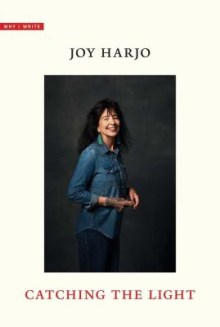
From 2019 to 2022 Joy Harjo was the 23rd Poet Laureate of the United States, and was the first Native American in that position. She is a member of the Muscogee Creek Nation that is geographically located in Tulsa, Oklahoma. Harjo is clear in affirming that the Muscogee Creek Nation Reservation is “at the border of three Native nations that also include the Osage and Cherokee. We honor and acknowledge those original keepers, past, present, and future, who care for these lands. We acknowledge the source of the gifts of our living, for without this Earth, or Ekvnvcakv, we would be without shelter, clothing, food, or inspiration. Consider that the Earth mind, architectures, and aesthetics shape the mother root of our imagination here.” Over years past, the demarcation of states and their borders was made by the United States government, and these divisions layered over the original lands of numerous Indigenous peoples.
This book is deceptive in its length because Joy Harjo tackles seemingly apparent and uncomplicated ideas about poetry, e.g., Why write poetry? How to write poetry? What subjects are appropriate for this genre? For Indigenous peoples all forms of art are sacred and are inclusive aspects of daily life. They are part of the entire life cycle. Therefore, Harjo's examination and analysis of questions, that might be thought of as obvious to non-Indigenous peoples, are complex and rich. This is truly a meditation on life, and a contemplation about poetry and how it saved and enriched her life, and continues to do so.To non-Indigenous peoples the arts might be thought of as a mean of expression, or entertainment, or embellishment, all of which could be miniscule aspects of what the arts are to Indigenous peoples. The arts are major parts of the heart and soul of life for them.
For 50 years Joy Harjo has been writing poetry even though that was not her initial art form--it was painting. In her own home she was inspired by the oil paintings of her grandmother, Naomi Harjo, “a full-blood and deeply cultural Mvskoke Creek. She also played saxophone in Indian Territory before Oklahoma was a state.” Her grandmother died long before Joy Harjo was born. Naomi Harjo’s sister, Aunt Lois Harjo, was a painter in oils and worked at the Creek Council House and taught art to community members. She mentored her niece. As with her other relatives, Joy Harjo is a musician, a dancer, a visual artist, a writer and a poet.
In 1967 Harjo was a student at the Institute of American Indian Arts (IAIA). This was a crucial period because her immediate family life was troubled and dark, and she considered running away from home. In the beginning she was "a reluctant writer, but poetry enabled her “to catch the light.” She advises others that, "The most powerful moment is just ... starting. Start anywhere to catch the light." As a genre, poetry is a compressed form of writing using language to convey thoughts and feelings, often using images as expressed in writing. All of this is reflected in the prose of Joy Harjo as she writes about poetry.
On March 23, 2023, she was honored with the Ivan Sandroff Lifetime Achievement Award from the National Book Critics Circle. More information about that honor and her accomplishments can be read about here.
Books by and about Joy Harjo can be found here.